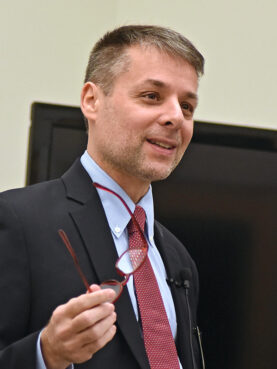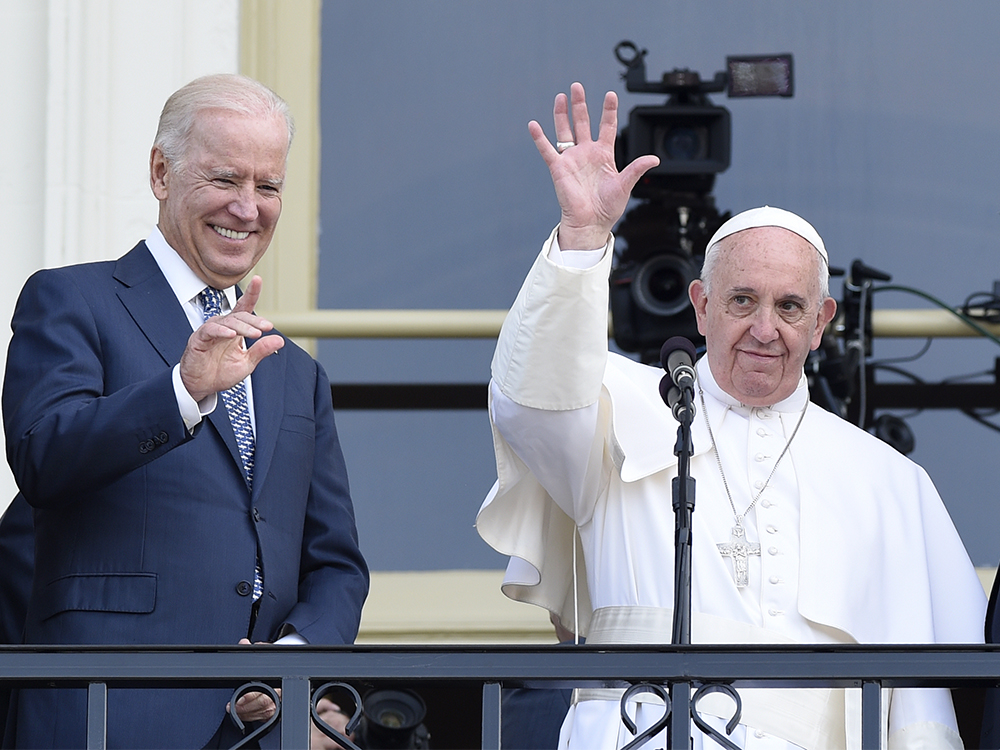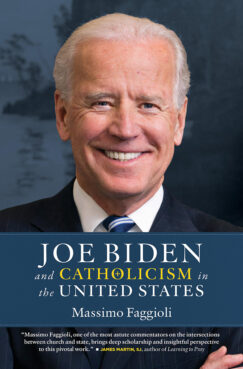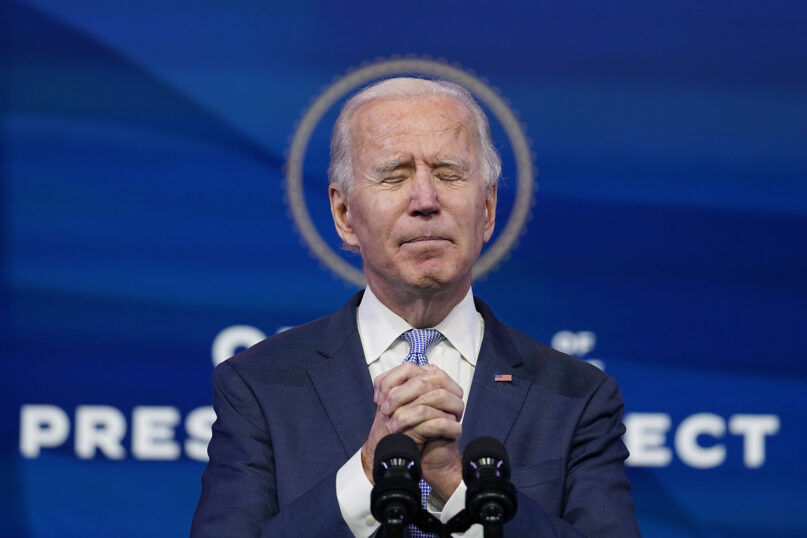(RNS) — For a decade, Massimo Faggioli has taught a class on U.S. Catholics and politics, most recently at Villanova University where he is a professor of theology and religious studies. But when it started to look increasingly likely that Joe Biden would become the Democratic nominee, Faggioli began to consider how this time in history is a particularly fraught one for a second Catholic U.S. president.
Out of that thinking grew his new book, “Joe Biden and Catholicism in the United States,” published on Inauguration Day.
The book names four U.S. Catholics who have run for president (Al Smith, John F. Kennedy, John Kerry and Biden) and includes a fifth who may be better known than any of these real-life examples: Jed Bartlet, played by Martin Sheen in the 1999-2006 hit TV series “The West Wing.”
Of these, only Biden has had to deal with a U.S. Conference of Catholic Bishops that is in the midst of what Faggioli calls a “reactionary” revolt. A number of the American bishops and cardinals supported what is described by some as an attempted coup of Pope Francis by former U.S. nuncio Archbishop Carlo Maria Viganò in 2018. Others want to undo the reforms of the Second Vatican Council or notch a victory in the culture war by denying Biden Communion for his support of legal abortion.
RNS talked to Faggioli about his new book and how Biden might overcome the USCCB’s early hostility and cooperate with Pope Francis. The interview was edited for length and clarity.
You describe Joe Biden as a kind of liminal figure, caught between the 20th and 21st century. Explain what you mean.

Villanova Professor Massimo Faggioli speaks at the Community of St. Peter, Thursday, Oct. 24, 2019, in Cleveland, Ohio. (Photo by Peggy Turbett/ Community of St. Peter)
He is a cradle Catholic, born and raised in a world shielded from pluralism, much more than today. But he becomes president at a time when U.S. Catholicism is reassessing in a very negative way the possibility of living in a democratic, pluralistic society. So he was born in one world and reached the highest office in a very different world and a very different church.
What’s fascinating about his Catholicism is that he embodies an attempt to bring back a Catholic identity that doesn’t need other adjectives. Today, there’s always an adjective qualifying “Catholic”: a liberal, conservative, traditionalist and so on. This is the phenomenon of branding. But that’s not Joe Biden. His Catholicism is co-essential with his life and identity. It’s very important to understand that he’s not a born-again Christian. In some ways, he’s the opposite of that. So it’s a synthesis between an old Catholicism that is dying — structurally, institutionally and politically — and the new one being born.
You point to areas where Francis and Biden agree, such as the environment and immigration. More generally, how does the Vatican view Biden?
There’s a sigh of relief in the Vatican because Biden’s election means a return to multilateralism, to cooperation with international organizations, which has become in the last 50, 60 years a pillar of the Vatican concept of global community. It’s the way you can address all other challenges — peace, denuclearization, etc. For the Vatican it was a real worry to have an America talking and acting on the principle of “America Alone.”
Biden is a product of the Washington establishment, and not as close as Francis is to a third-world agenda. But certainly there can be much more cooperation in the short term. In the long term, there are natural differences — on China, the Middle East, Latin America. But it will take time for them to emerge. Right now, the dominant feeling is that we can go back to a predictable system of relations and cooperation, beginning with the U.N.

Pope Francis, right, flanked by Vice President Joe Biden, waves to the crowd on Capitol Hill in Washington on Sept. 24, 2015, as they stand on the Speaker’s Balcony on Capitol Hill, after the pope addressed a joint meeting of Congress inside. (AP Photo/Susan Walsh)
You note that Francis has embraced a vision of Catholicism that is no longer centered on the West. What is his attitude to the U.S.?
This is one of the major changes between Francis and his predecessors. John Paul II and Benedict XVI had a special relationship with the United States for different reasons — anti-communism for John Paul II and a very negative take on Islam for Benedict XVI. Francis’ understanding of the United States is shaped by a typical Latin American Catholic perception, by the United States’ support for dictatorships on the continent.
In the last few years, we’ve seen the undeniable rise of Asia. This part of the world is going to be more important for the Vatican because the future of Christianity is more there than in North America or Europe. At the same time, America cannot be ignored. There is a deep worry in the Vatican for what America has gone through in the last four years. Francis is not ignoring America. That’s not thinkable. When he has spoken on marriage and divorce and gays and abortion, he knew it would create a huge backlash from the U.S. Catholic bishops, and he did it anyway.
You devote a large part of the book to exploring the changes in the U.S. Conference of Catholic Bishops. You call some of them neoconservatives and others neotraditionalists. Explain what you mean by that.
Neoconservative is a movement that began in Catholic intellectual circles in the United States in the 1980s. They thought Catholic liberalism in the 1960s and 1970s had gone too far and we should go back to a more moderate idea of church. They were not aiming at an upheaval of the whole system. They wanted a rebalancing. In the last 15 years, since the election of Benedict in 2005, some in those same circles have become neotraditionalists. They say the teachings of the Second Vatican Council were wrong: Let’s go back to a pre-Vatican II theology.
When Trump becomes president there’s also an embrace of a political theology that embraces ethno-nationalism among the U.S. bishops. There’s a rejection of any discourse on racism, gender equality, etc. This is something that has happened in various places in the Catholic Church, but in other countries, it’s fringe. In this country, it is much bigger.
How has the neotraditionalist wing expressed itself?

“Joe Biden and Catholicism in the United States” by Massimo Faggioli. Courtesy image
It’s natural to have a split in the bishops’ conference between more conservative and liberal bishops. But during the Trump years, the USCCB has never said anything about the rule of law or voting. Nothing. That’s not how a bishops’ conference usually behaves in a Democratic country. When democracy is under threat, you always have bishops saying, ‘“This is where we stand.” We haven’t seen that in this country. Why? Because they can’t afford to say anything negative about Donald Trump.
After the Jan. 6 assault on the Capitol there were statements saying, “Let’s not resort to violence.” But there is no statement calling what the president did what it was, or calling his lies, lies. Other cardinals and bishops have noticed. The cardinal of Myanmar represents a tiny percentage of the population of Myanmar, but immediately after the coup, he said, “We Catholics are in favor of democracy, of the constitution, rule of law.”
The Catholics in the United States represent more than one-fifth of all the population, and in four years you never had anything comparable to what in one day the cardinal of Myanmar said. This is not how the Catholic Church behaves in a modern democracy under threat.
Can Biden ignore the bishops’ conference and deal directly with the Vatican?
The Vatican has already opened a channel of communication with the new administration. The U.S. bishops’ conference has cornered itself. It has bad relations, not only with the White House but with the pope.
It’s not in Biden’s interest to challenge or criticize the bishops. He doesn’t need that. But Biden and the pope can understand each other without the need to involve the U.S. bishops, who are effectively marginalized. They are dealing with an open rift among themselves. I suspect that’s going to last. In the last eight years, the USCCB has become immovable.
All those bishops and cardinals Francis appointed have never been elected to a position of leadership in the USCCB. Many have just given up. Very few are willing to say something publicly. So it’s a Catholic Church effectively without a leadership that is taken seriously.
You write that the Catholic Church is in the midst of a “soft schism.” What do you mean?
I don’t think it will be a schism like in the Middle Ages, but the polarization in the Catholic Church in this country goes much deeper than political behavior. More than 50% of white Catholics voted again for Donald Trump in 2020. Those political behaviors reflect a split between different kinds of Catholic cultures. It’s more than a legitimate diversity of political ideas. Bishops hostile to Pope Francis in 2018 looked with sympathy at Vigano’s attempts to unseat Pope Francis.
This is not normal. When good Catholics go as far as trying to unseat a legitimately elected pope, this is a warning sign. None of those bishops regretted what they said. This is a stain on this church, because when you go as far as it went in 2018, it’s a sign of a sickness. Donald Trump was an accelerator of an ecclesial dynamic that was unhealthy already.





